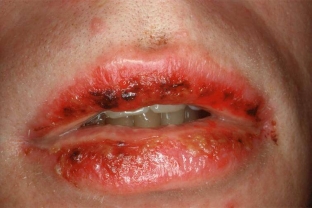Stevens syndrome is distinguished in dermatology and allergology – Johnson, which is the most severe manifestation of erythema multiforme exudative. It is believed that the development of the syndrome occurs according to the mechanism of development of erythema, but is a hyperergic reaction of the body to a substance that has allergenic properties. The syndrome was described by scientists Stevens and Johnson, hence the name. Also, the disease is also called mucocutaneous-ocular syndrome. Find out the clinical manifestations of Stevens syndrome – Johnson in our article.
Symptoms of Stevens-Johnson syndrome. Skin lesions
For Stevens syndrome – Johnson is characterized by an acute development of the disease with a sharp increase in body temperature to 39-400. Further, the temperature decreases, but subfebrile condition persists for a long time. There are signs of intoxication of the body: muscle weakness, lethargy, headaches, sleep disturbance and dizziness.
On the skin, against the background of a sharp deterioration in the condition, various elements of the rash appear in large quantities. Erosions, vesicles, ulcers and blisters are formed. Characteristics of the rash read further on estet-portal.com. Elements of a rash in Stevens syndrome – Johnson spread not only to the surface of the skin, but also to the mucous membranes. The presence of large surfaces of rashes further worsen the condition. Lesions of the oral mucosa lead to difficulty in eating and exhaustion of the body.
Characteristics of the rash in Stevens syndrome – Johnson:
- The elements of the rash on the skin are red – bluish tint and oval shape.
- Large blisters up to 5 cm in diameter and in large numbers form on the surface of papules, spots and plaques.
- When sipping on the covering of the bladder, exfoliation of areas of externally unchanged skin or mucous membrane occurs, which indicates a positive symptom of Nikolsky.

Muscosal lesions in Stevens syndrome – Johnson
Injury to the mucous membranes of the eyes in Stevens syndrome – Johnson can provoke the development of blindness. When examining the eyes, the conjunctiva is edematous, blisters, ulcers and eroded areas and crusts are detected. The skin of the eyelids is full-blooded, edematous. In this state, panophthalmitis and keratitis often develop.
The mucous membrane of the nose is affected with the development of frequent nosebleeds. The process can spread to the mucous membranes of the larynx and trachea. In this case, the act of breathing may be disturbed, which requires a tracheostomy.
The lesions also extend to the mucous membranes of the stomach – intestinal tract. Always Stevens Syndrome – Johnson is accompanied by damage to the mucous membrane of the genital organs and the anus.
Influence of Stevens syndrome – Johnson for the work of internal organs
The course of the disease is very severe with a possible fatal outcome, which often occurs against the background of damage to the central nervous system. The development of a coma disrupts the functions of vital organs.
In the development of Stevens syndrome – Johnson, the immune system is disrupted, which contributes to massive infection of the affected areas of the skin and mucous membranes.
In patients with Stevens-Johnson syndrome, the quality and quantity of saliva changes. It becomes viscous, thick, its cleansing properties are lost. At the same time, it becomes impossible to carry out any manipulation in the oral cavity.
Patients with Stevens syndrome – Johnson should be registered with a dermatologist for ongoing symptomatic treatment.









Add a comment